
Aloe is a genus containing over 650 species of flowering succulent plants. The most widely known species is Aloe vera, or "true aloe". It is called this because it is cultivated as the standard source for assorted pharmaceutical purposes. Other species, such as Aloe ferox, are also cultivated or harvested from the wild for similar applications.
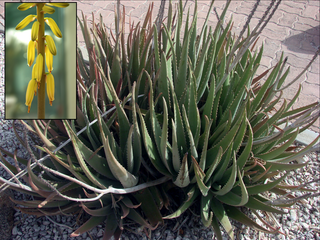
Aloe vera is a succulent plant species of the genus Aloe. It is widely distributed, and is considered an invasive species in many world regions.

Aloe ballyi is a species of flowering plant in the family Asphodelaceae, native to Kenya and Tanzania.
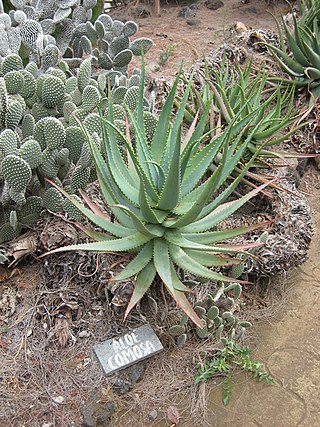
Aloe comosa is a species of flowering plant in the Asphodelaceae family. It is commonly called Clanwilliam aloe) and is endemic to South Africa.

Aloe squarrosa is a species of flowering plant in the Asphodelaceae family. It is from the island of Socotra, Yemen.

Trichoglottis, commonly known as cherub orchids or 毛舌兰属 , is a genus of flowering plants in the family Orchidaceae. Orchids in this genus are epiphytic plants with thick roots, relatively thick, fibrous stems and many large, thick, leathery leaves arranged in two ranks. The flowers are usually small and yellowish with light brown or purple markings. The flowers have broad sepals, narrower petals and a labellum which has three lobes and is often hairy. There are about 85 species distributed from tropical and subtropical Asia to the north-western Pacific. Most species grow in rainforest.
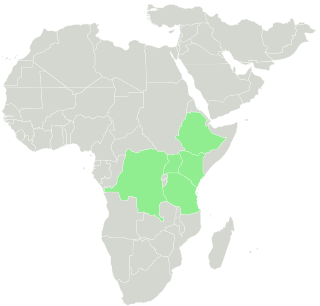
Subularia monticola is one of the water loving, annuals of the genus Subularia in the family Brassicaceae. It lives in the cool, moist high elevations of Ethiopia, Kenya, Tanzania, Uganda and Zaire.

Aloe ferox, commonly known as bitter aloe, is a species of flowering plant in the family Asphodelaceae. This woody aloe is indigenous to southern Africa. It is one of several Aloe species used to make bitter aloes, a purgative medication, and also yields a non-bitter gel that can be used in cosmetics.

Aloiampelos commixta is a flowering plant in the Asphodelaceae family. It is commonly called Table Mountain aloe, and is a rare succulent plant that is endemic to the Cape Peninsula, South Africa. It naturally occurs only on the Table Mountain range, within the city of Cape Town.

Aloiampelos ciliaris, formerly Aloe ciliaris, the common climbing-aloe, is a thin, tough, rapidly growing succulent plant from South Africa.
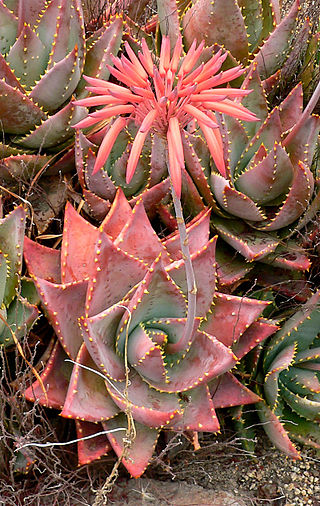
Aloe perfoliata, the rubble aloe or mitre aloe, is a hardy creeping aloe, found in rocky, mountainous areas throughout the Western Cape, South Africa.

Aloe pearsonii is a very distinctive and unusual species of aloe, that is naturally endemic to the arid Richtersveld area on the border between South Africa and Namibia.
Canarina eminii is a species of flowering plant in the family Campanulaceae. It is an epiphytic or terrestrial, usually glaucous, herb. Its root is thick, often with a corky surface layer. Its stems are erect and scandent, pendent up to several meters in length, usually with a fine purplish mottling. Its leaves are triangular to ovate, up to 10 cm long, acute with cordate to cuneate base, dentate, double dentate or double serrate. Its corollas are funnel-shaped to 7.5 cm long, orange to orange-red with darker venation.
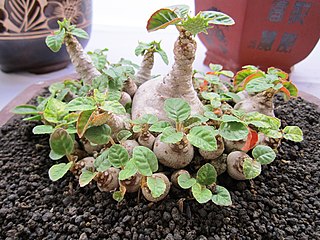
Dorstenia foetida is a succulent plant in the genus Dorstenia, which is native to Eastern Africa and Arabia. It is a very variable species with a wide distribution.
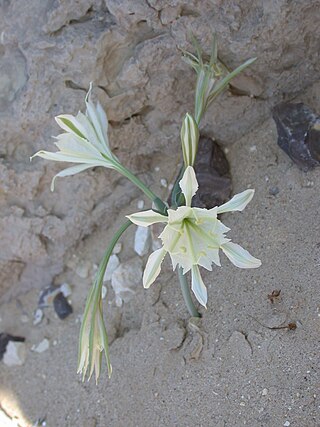
Pancratium sickenbergeri is a species of flowering plant in the Amaryllidaceae family. It is a Saharo-Arabian plant that grows in deserts, such as the Negev. It is native to Israel, Egypt, Lebanon, Palestine, Saudi Arabia, and Syria. The flowers look like the Mediterranean species Pancratium maritimum, but the leaves of P. sickenbergeri are curly and the plant is much smaller. Unusually for the desert, the seeds are distributed by floodwaters when they occur in the winter.

Aloeae is a tribe of succulent plants in the subfamily Asphodeloideae of the family Asphodelaceae, consisting of the aloes and their close relatives. The taxon may also be treated as the subfamily Alooideae by those botanists who retain the narrower circumscription of Asphodelaceae adopted prior to the APG III system. Typically, plants have rosettes of more or less succulent leaves, with or without a distinct stem. Their flowers are arranged in racemes and tend to be either small and pale, pollinated by insects, or larger and more brightly coloured, pollinated by birds. As of 2017, 11 genera are recognized, most created since 2010 by splitting off another five genera from Aloe and another two from Haworthia. Only two genera, Aloe and Aloidendron, are native outside southern Africa, extending northwards to the Arabian Peninsula. Seven genera are restricted to South Africa, some with small ranges. Members of the Aloeae are cultivated by succulent plant enthusiasts; Aloe species especially are used in temperate climates as ornamental garden plants. Some species are used in traditional medicine. Aloe vera and Aloe ferox are cultivated for their extracts, whose uses include moisturizers and emollients in cosmetics.

Aloe babatiensis is an aloe which is found in northern Tanzania.

Aloe kedongensis is a species of aloe which occurs in Kenya and northern Tanzania.
Aloe aaata is a species of aloe plant found in Saudi Arabia specifically in the Asir Province. The aloe has a perennial life cycle and has evergreen leaves, additionally cuttings of the stem can be used for propagation of the plant along with offsets.

















